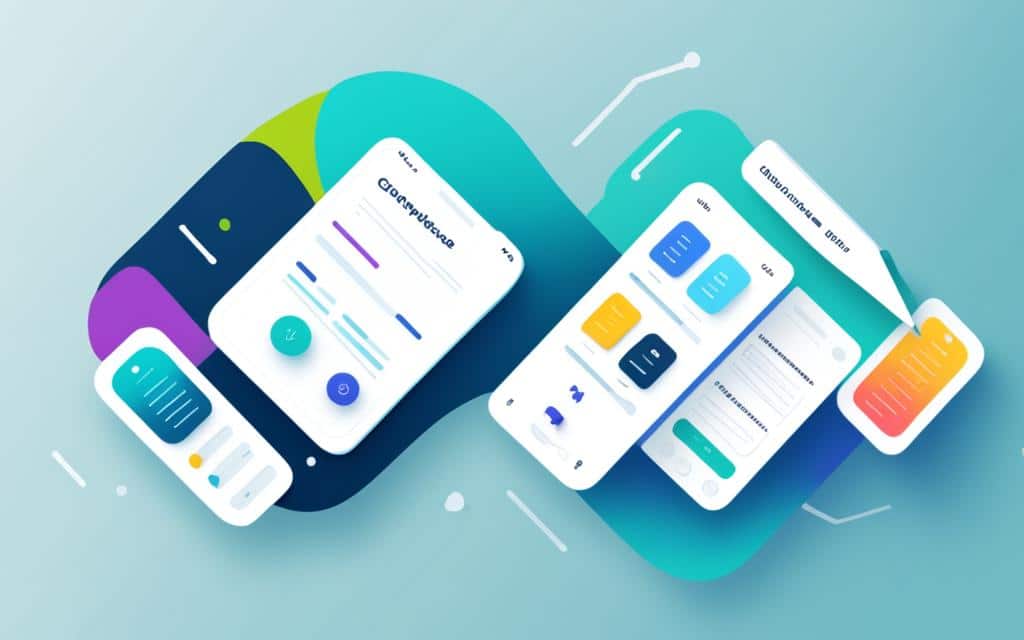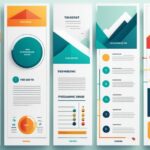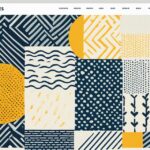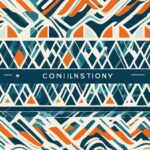Table of Contents
UI/UX Graphic Design, Website Design, UX Design, UI Design, Graphic Design
The intersection of UI/UX and graphic design plays a crucial role in creating visually stunning and user-friendly websites. It involves combining the principles of UX design, which focuses on understanding user needs and crafting seamless experiences, with the artistic elements of UI design, such as visual layouts, buttons, and icons. Graphic design adds an aesthetic finesse and effective communication through carefully chosen fonts, colors, and visual elements. Together, these design realms collaborate to create tomorrow’s digital experiences that exceed user expectations.
When it comes to website design, UI/UX and graphic design work hand in hand to deliver exceptional results. While UX design seeks to understand the users’ needs and create intuitive interactions, UI design focuses on the visual appeal and layout of the website. Graphic design brings a harmonious blend of aesthetics and effective communication, ensuring that every element of the website resonates with the users.
Whether it’s crafting a seamless user experience, curating visually appealing layouts, or communicating messages with impact, the collaboration between UI/UX and graphic design is essential. By prioritizing functionality and aesthetics, designers can create digital experiences that captivate users and leave a lasting impression.
In the following sections, we will delve deeper into the roles of UX design and UI design, exploring how they contribute to the overall success of a website. We will also examine the impact of graphic design on website aesthetics and effective communication. Finally, we will explore the collaborative symphony of UI/UX and graphic design, shaping the digital experiences of tomorrow.
Understanding the Role of UX Design
UX design, short for User Experience Design, plays a pivotal role in creating websites that meet user needs and deliver exceptional experiences. It goes beyond mere functionality to focus on crafting intuitive interactions and seamless user journeys. By conducting thorough research, prototyping, and usability testing, UX designers act as digital detectives, delving deep into user journeys and needs to create websites that resonate with users. Through their efforts, every interaction on a website is designed to be user-friendly and enjoyable.
UX designers are committed to understanding user needs and aspirations. By empathizing with users and studying their behaviors, they gain valuable insights into how websites can be designed to cater to their needs. This user-centric approach ensures that every aspect of the website is tailored to provide a satisfying experience.
By creating user journeys, UX designers map out the steps users take as they navigate through a website. This process allows designers to identify pain points, streamline processes, and optimize the overall user experience. User journeys are an essential tool in understanding user expectations, creating efficient workflows, and guiding users towards their desired outcomes.
One of the key goals of UX design is to establish intuitive interaction patterns. By prioritizing ease of use and clear communication, UX designers ensure that users can effortlessly navigate a website and understand how to interact with its various elements. From intuitive navigation menus to clear call-to-action buttons, every element is carefully designed to guide users through their digital journey.
“Good design is making something intuitively easy for users.” – Steve Jobs
An intuitive interaction is like a conversation between a user and a website. It anticipates their needs and responds to their actions seamlessly. This level of intuitive interaction requires a deep understanding of user behavior and preferences, which is at the core of UX design.
The goal of every UX designer is to create a website that not only meets user needs but also exceeds their expectations. By continually iterating and improving the user experience, designers strive to deliver websites that leave a lasting positive impression.
| Benefits of UX Design | Examples |
|---|---|
| Enhanced usability | Intuitive navigation menus, clear call-to-action buttons |
| Improved user satisfaction | User-friendly interfaces, streamlined processes |
| Higher conversion rates | Optimized workflows, persuasive design elements |
| Increased brand loyalty | Memorable experiences, personalized recommendations |
UX design ensures that a website is an enjoyable and efficient tool for users to achieve their goals. By deeply understanding their needs and providing seamless interactions, UX design enhances the overall user experience and contributes to the success of a website.
Exploring the Artistry of UI Design
When it comes to website design, UI design takes center stage as the visual maestro. With a focus on creating captivating digital experiences, UI designers curate buttons, icons, and layouts that are visually appealing and enticing. The goal is to create a digital canvas that captures users’ attention and guides their journey through strategic use of size, color, and placement.
One of the key aspects of UI design is the emphasis on visual appeal. From the choice of fonts to the color palette, every element is carefully considered to create a harmonious and visually pleasing user interface. UI designers also establish consistent design languages for fonts, colors, and icons, ensuring a cohesive and intuitive experience for users.
Central to UI design is the concept of responsive design. UI designers strive to create elements that adapt to user actions, providing an engaging and interactive experience. Whether it’s a button that changes color on hover or a layout that adjusts seamlessly on different devices, UI design ensures that every element of the user interface responds to user actions.
The Visual Appeal of UI Design
UI designers play a critical role in enhancing the visual appeal of a website. By leveraging their expertise in button design, layout design, and visual hierarchy, they create user interfaces that are not only aesthetically pleasing but also intuitive and easy to navigate.
UI designers combine artistic flair with a deep understanding of user needs and behaviors, crafting visually stunning interfaces that leave a lasting impression.
Button design is an essential element of UI design. UI designers carefully consider the shape, size, and placement of buttons to encourage users to take specific actions. By employing visual cues and microinteractions, they guide users through the website’s functionalities and make the user experience more engaging.
Layout design is another key aspect of UI design. UI designers use grids and whitespace to create visually balanced and organized layouts. They strategically position elements to guide users’ attention and ensure a seamless flow through the website. Consistency in layout design elements, such as headers, navigation bars, and content sections, also contributes to a cohesive user experience.
The Importance of UI Design in User Interface Design
UI design plays a fundamental role in user interface design, contributing to the overall user experience and satisfaction. A well-designed UI can make or break a website, influencing how users interact with the interface and perceive the brand. With a focus on visual appeal, button design, layout design, and responsive design, UI designers create interfaces that are both aesthetically pleasing and user-friendly.
Take a look at the example below to see how UI design can enhance the visual appeal and user experience of a website:
Through their artistry in UI design, designers create digital experiences that captivate users and leave a lasting impression. The combination of visual appeal, button design, layout design, and responsive design ensures that every element of the user interface is carefully crafted to provide an engaging and seamless experience for users.
The Impact of Graphic Design on Website Aesthetics
When it comes to website design, graphic design plays a crucial role in elevating the overall aesthetics and effectiveness of the visual elements. It goes beyond creating visually appealing layouts and images; graphic design also focuses on effective communication through the careful selection of fonts, colors, and other visual elements. The use of these design elements is meticulous, with the aim of captivating the viewer’s attention while conveying messages with clarity and impact.
Graphic designers understand the power of aesthetics in creating memorable and engaging experiences for website visitors. They carefully choose fonts that communicate the right tone and personality, ensuring that the typography contributes to the overall visual appeal and enhances readability. Similarly, the choice of colors is not arbitrary but strategic, as different colors evoke specific emotions and associations. By selecting the right colors, graphic designers create a harmonious and visually pleasing experience.
Visual elements such as images, illustrations, and icons are also essential in graphic design. They add depth, context, and visual interest to the website, enhancing the overall user experience. Graphic designers have the expertise to select and create visual elements that align with the brand’s identity, while also effectively communicating the intended messages.
The synergy of form and function is a distinguishing feature of successful graphic design. By combining the principles of aesthetics and effective communication, graphic designers create memorable designs that leave a lasting impression on website visitors. It goes beyond making things look beautiful; it’s about creating designs that effectively communicate and resonate with the target audience.
In conclusion, the impact of graphic design on website aesthetics cannot be overstated. It is through the meticulous selection of fonts, colors, and visual elements that designers create visually stunning and effective websites. By understanding the power of aesthetics and its role in effective communication, graphic designers bring life and personality to digital experiences, ultimately creating memorable designs that captivate and engage users.
The Collaborative Symphony of UI/UX and Graphic Design
The intersection of UI/UX and graphic design brings together the collaborative efforts of these design realms to craft digital experiences that anticipate user needs and deliver visually stunning and functionally seamless websites. It’s not just about aesthetics, but also about creating a harmonious blend that exceeds user expectations. In this collaborative symphony, UI/UX and graphic design set the trends by fusing artistry with user-centric functionality, shaping the digital experiences of tomorrow.
Tomorrow’s Digital Experiences
Tomorrow’s digital experiences require a delicate balance between form and function. UI/UX and graphic design collaborate to create user-centric websites that go beyond visual appeal. They understand that users expect more than just an attractive interface; they want a seamless and intuitive experience. By combining the principles of UI/UX and leveraging the artistic elements of graphic design, designers create experiences that not only meet user expectations but also push the boundaries of what is possible in digital design.
User Expectations: The Driving Force
User expectations have evolved rapidly in the digital age. Today, users demand websites that are easy to navigate, visually captivating, and provide value. They expect websites to load quickly, be responsive across devices, and offer intuitive interactions. UI/UX and graphic design collaboration addresses these expectations by producing interfaces that are user-friendly, visually engaging, and functionally effective.
“UI/UX and graphic design collaboration is vital for creating websites that resonate with users on both a functional and emotional level. It’s about understanding the user, anticipating their needs, and delivering an experience that surpasses their expectations.”
A Harmonious Blend: Artistry and Functionality
The collaboration between UI/UX and graphic design creates a harmonious blend where artistry and functionality seamlessly interact. UI/UX designers lay the foundation by understanding user needs, creating user journeys, and crafting intuitive interactions. Graphic designers then bring their expertise in visual communication, selecting fonts, colors, and visual elements that enhance the overall aesthetic appeal and effectively convey the website’s message. The result is a harmonious blend of art and technology that captivates users while providing a seamless and enjoyable digital experience.
Tomorrow’s digital experiences will continue to evolve as user expectations shift and technology advances. But one thing remains constant: the collaborative symphony of UI/UX and graphic design will continue to shape the future of website design, creating digital experiences that delight and exceed user expectations.
In Summary
The collaboration between UI/UX and graphic design is essential for creating digital experiences that anticipate user needs and exceed expectations. By blending artistry with user-centric functionality, designers shape tomorrow’s digital experiences. User expectations are at the forefront, and UI/UX and graphic design collaborate to create websites that are visually stunning, functionally seamless, and future-proof. Together, they set the trends and shape the future of website design.
Conclusion
The intersection of UI/UX and graphic design plays a vital role in the creation of user-friendly and visually captivating websites. By combining their expertise in understanding user needs, designing intuitive interactions, and prioritizing visual appeal, designers can exceed user expectations and provide exceptional digital experiences. The collaboration between UI/UX and graphic design results in a harmonious blend of artistry and functionality, setting the trends and shaping the future of website design.
Website design is no longer just about functionality; it is about creating experiences that resonate with users on a deeper level. UI/UX designers ensure that every interaction is seamless and user-centric, guiding users effortlessly through their journey. On the other hand, graphic designers add their artistic touch, precisely selecting fonts, colors, and visual elements that not only look appealing but also effectively communicate the intended message.
Tomorrow’s digital experiences demand a user-centric approach, where aesthetics and functionality go hand in hand. The collaboration between UI/UX and graphic design creates websites that not only fulfill user needs but also delight them with an immersive visual experience. The seamless integration of these design realms defines the success of modern website design, setting the stage for the future of digital experiences.
FAQ
What is UI/UX graphic design?
UI/UX graphic design is the intersection where UI design, UX design, and graphic design come together to create visually stunning and user-friendly websites. It combines the principles of UX design, which focus on understanding user needs and crafting seamless experiences, with the artistic elements of UI design and the aesthetic finesse and effective communication of graphic design.
What is the role of UX design in website design?
UX design is like a detective’s quest into understanding user journeys and needs. Through research, prototyping, and usability testing, UX designers aim to create experiences that resonate with users. Their focus is on crafting intuitive interactions, seamless user journeys, and ensuring that every interaction on a website is user-friendly and enjoyable.
How does UI design contribute to website aesthetics?
UI design is the visual maestro of the website design process. It involves curating buttons, icons, and layouts to create a visually appealing and enticing digital canvas. UI designers prioritize visual appeal and create layouts that guide users’ attention through strategic use of size, color, and placement. They also focus on creating consistent design languages for fonts, colors, and icons.
What role does graphic design play in website aesthetics?
Graphic design plays a crucial role in elevating website aesthetics and effective communication. It involves meticulous choices of fonts, colors, and visual elements to captivate the eye while conveying messages with clarity and impact. Graphic designers ensure that the visual elements of a website not only look appealing but also effectively communicate the intended message.
How do UI/UX and graphic design collaborate in website design?
The intersection of UI/UX and graphic design brings together the collaborative efforts of these design realms to craft digital experiences that anticipate user needs and deliver visually stunning and functionally seamless websites. This collaboration aims to create a harmonious blend of artistry and functionality, setting the trends and shaping the future of website design.













